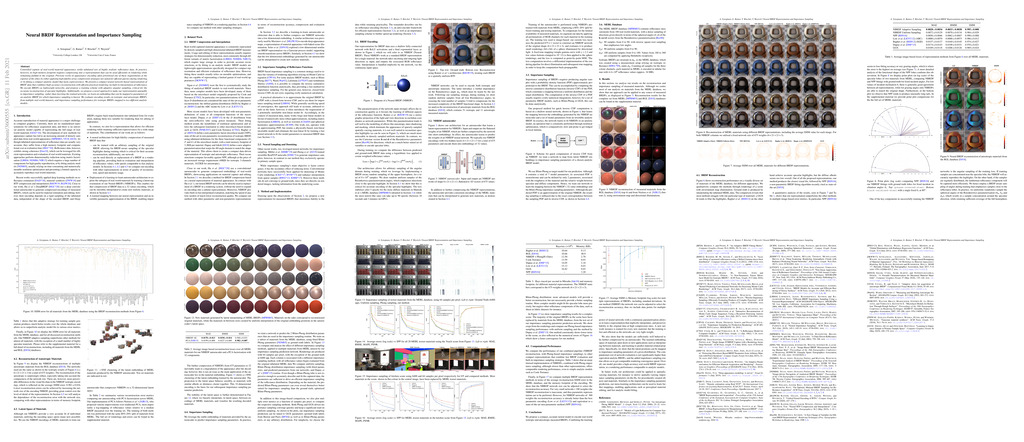Neural BRDF Representation and
Importance Sampling
Importance Sampling
-
Department of Computer Science, University College London, UK.

Controlled capture of real-world material appearance yields tabulated sets of highly realistic reflectance data. In practice, however, its high memory footprint requires compressing into a representation that can be used efficiently in rendering while remaining faithful to the original. Previous works in appearance encoding often prioritised one of these requirements at the expense of the other, by either applying high-fidelity array compression strategies not suited for efficient queries during rendering, or by fitting a compact analytic model that lacks expressiveness. We present a compact neural network-based representation of BRDF data that combines high-accuracy reconstruction with efficient practical rendering via built-in interpolation of reflectance. We encode BRDFs as lightweight networks, and propose a training scheme with adaptive angular sampling, critical for the accurate reconstruction of specular highlights. Additionally, we propose a novel approach to make our representation amenable to importance sampling: rather than inverting the trained networks, we learn an embedding that can be mapped to parameters of an analytic BRDF for which importance sampling is known. We evaluate encoding results on isotropic and anisotropic BRDFs from multiple real-world datasets, and importance sampling performance for isotropic BRDFs mapped to two different analytic models.
- Paper
PDF 16 MB - Paper (lowres)
PDF 3.1 MB - Supplemental MERL
PDF 55 MB
- Presentation Slides
PDF 5.9 MB - Code
WebGL Demo
The WebGL widget uses our neural encodings (NBRDF) to render a scene with measured materials from MERL. Pre-trained network weights are read from a texture file, and inference is implemented using GLSL.
Code and Pre-trained Models
Code is available in the github repository. We provide pre-trained NBRDFs for measured materials from multiple databases:
- Python code to train NBRDF networks.
- Mitsuba plugin (C++) to render using pre-trained NBRDFs.
- All materials from the MERL database.
- Isotropic materials from the RGL database.
- Materials from Nielsen et al. (2015).
- NBRDF training script (alternative implementation in PyTorch by Michael Fischer).
Paper
BibTeX
xxxxxxxxxx@article{sztrajman2021nbrdf, author={Alejandro Sztrajman and Gilles Rainer and Tobias Ritschel and Tim Weyrich}, title = {Neural BRDF Representation and Importance Sampling}, journal = {Computer Graphics Forum}, year = {2021}, doi = {https://doi.org/10.1111/cgf.14335}, url = {https://onlinelibrary.wiley.com/doi/abs/10.1111/cgf.14335}}
Acknowledgement
This project has received funding from the European Union’s Horizon 2020 research and innovation program under the Marie Skłodowska-Curie grant agreement No 642841. The webpage template was inspired by this project. The WebGL application is based on an implementation by [Bagher et al. 2016].
